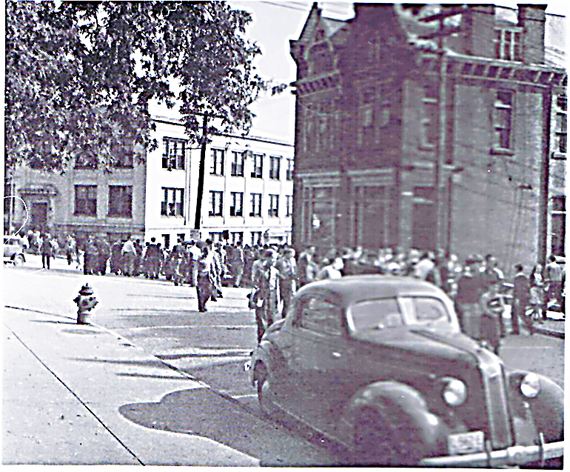A brief history of the Potters National Bank building.
In July 1881 the Potter's National Bank established its new facilities at the intersection of Broadway and Fourth Streets. As in the case with the First National Bank, pottery manufacturers dominated the board with William Brunt, Jr., John N. Taylor, James H. Goodwin, Noah Frederick, William and Joseph Cartwright, and F.D. Kitchel directing the operation of the bank
Driven by the proliferation of new pottery manufacturers and increased competition, some potteries attempted mergers while others sought to stabilize markets and control the industry through the formation of trusts. In the face of stiff competition from the area's largest potteries, six of the smaller potteries merged in June of 1901 to form the East Liverpool Potteries Company. The consolidation consisted of the Globe Pottery Company, the East Liverpool Pottery Company, the East End Pottery Company, Wallace and Chetwynd, and the George C. Murphy Pottery Company, all of East Liverpool, as well as the United States Pottery Company of Wellsville. The merger was consumated so that they could handle large orders by jobbers. The combined capacity of the six firms was thirty-one kilns, equalling that of Knowles, Taylor and Knowles. Each plant owned stock in the new corporation and was operated individually with a single general manager over all of the potteries. The new firm purchased the former Potter's National Bank building at Fourth and Broadway where they established offices and a sample show room.The City of Hills and Kilns, page 127, 176.
FROM RIVERSTYLE (REVIEW SUNDAY SUPPLEMENT) SUNDAY NOVEMBER 21, 2010
A brief history on the building once located at 329 Broadway St., East Liverpool, Ohio:
WHAT ONCE WAS
In 1901, the bank moved from the original location to the corner of East Fifth and Washington streets - the present site of PNC Bank. (The current PNC is not related to Pottèrs National Bank, but was, Instead, named so when Pittsburgh National Corporation and Provident National Corporation merged into a new entity named PNC Financial Corporation.)
The name of "East Liverpool Potteries" was seen on the rear of the building before its demolition.
Simms later moved the Tribune operations to a building on the corner of Third Street and Center Alley.
The Croxall Chemical and Supply Company had moved to the Potters Supply Building along the railroad tracks.
[ Willis Smith, Trio Shoots Coin Collector ]
Smith sold the building to nearby Kent State University.
Information compiled by Michael O. McElwain and Joan Witt with the East Liverpool Historical Society.
The Early Days

Notice how well the PNB building and Central School compliment each other in their architectural style. If you look closely you can see the tops of the windows for the basement where the newspaper offices were. In later years those windows were gone as the sidewalk extended up to the building.
The picture below is probably around the same time perioid, 1900 or there abouts.
1.jpg)

East Liverpool supports the Liberty Loan Campaign - 1918

Something that literally thousands of young East Liverpool students from 1894 to 1968 while attending East Liverpool High School did for approxmately 180 days a year. The PNB building was embedded in their consciouness as they passed it or saw it daily, sometimes several times daily, as they went to and from school or changed classes.
This site is the property of the East Liverpool Historical Society.
Regular linking, i.e. providing the URL of the East Liverpool Historical Society web site for viewers to click on and be taken to the East Liverpool Historical Society entry portal or to any specific article on the website is legally permitted.
Hyperlinking, or as it is also called framing, without permission is not permitted.
Legally speaking framing is still in a murky area of the law though there have been court cases in which framing has been seen as violation of copyright law. Many cases that were taken to court ended up settling out-of-court with the one doing the framing agreeing to cease framing and to just use a regular link to the other site.
The East Liverpool Historical Society pays fees to keep their site online. A person framing the Society site is effectively presenting the entire East Liverpool Historical Society web site as his own site and doing it at no cost to himself, i.e. stealing the site.
The East Liverpool Historical Society reserves the right to charge such an individual a fee for the use of the Society’s material.